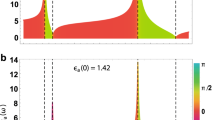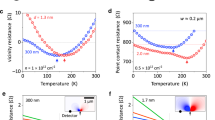Abstract
Coulomb drag is a frictional coupling between electric currents flowing in spatially separated conducting layers. It is caused by interlayer electron–electron interactions. Previously, only the regime of weak (d≫l) to intermediate (d∼l) coupling could be studied experimentally, where dis the interlayer separation and l is the characteristic distance between charge carriers. Here we use graphene–boron-nitride heterostructures with d down to 1 nm to probe Coulomb drag in the limit d≪l such that the two Dirac liquids effectively nest within the same plane, but can still be tuned and measured independently. The strongly interacting regime reveals many unexpected features. In particular, although drag vanishes because of electron–hole symmetry when either layer is neutral, we often find drag strongest when both layers are neutral. Under this circumstance, drag is positive in zero magnetic field but changes its sign and rapidly grows in strength with field. The drag remains strong at room temperature. The broken electron–hole symmetry is attributed to mutual polarization of closely spaced interacting layers.
This is a preview of subscription content, access via your institution
Access options
Subscribe to this journal
Receive 12 print issues and online access
$209.00 per year
only $17.42 per issue
Buy this article
- Purchase on Springer Link
- Instant access to full article PDF
Prices may be subject to local taxes which are calculated during checkout



Similar content being viewed by others
Change history
19 October 2012
In the version of this Article originally published online, the unit on the y axis of Fig. 3c was incorrect, it should have read "ρdrag (Ω)". This error has been corrected in all versions of the Article.
References
Solomon, P. M., Price, P. J., Frank, D. J. & La Tulipe, D. C. New phenomena in coupled transport between 2D and 3D electron-gas layers. Phys. Rev. Lett. 63, 2508–2511 (1989).
Gramila, T. J., Eisenstein, J. P., MacDonald, A. H., Pfeiffer, L. N. & West, K. W. Mutual friction between parallel two-dimensional electron systems. Phys. Rev. Lett. 66, 1216–1219 (1991).
Sivan, U., Solomon, P. M. & Shtrikman, H. Coupled electron-hole transport. Phys. Rev. Lett. 68, 1196–1199 (1992).
Eisenstein, J. P. & MacDonald, A. H. Bose–Einstein condensation of excitons in bilayer electron systems. Nature 432, 691–694 (2004).
Rojo, A. G. Electron-drag effects in coupled electron systems. J. Phys. 11, 31–52 (1999).
Suen, Y. W., Engel, L. W., Santos, M. B., Shayegan, M. & Tsui, D. C. Observation of a ν = 1/2 fractional quantum Hall state in a double-layer electron system. Phys. Rev. Lett. 68, 1379–1382 (1992).
Eisenstein, J. P., Boebinger, G. S., Pfeiffer, L. N., West, K. W. & He, S. New fractional quantum Hall state in double-layer two-dimensional electron systems. Phys. Rev. Lett. 68, 1383–1386 (1992).
Luhman, D. R. et al. Observation of a fractional quantum Hall state at ν = 1/4 in a wide GaAs quantum well. Phys. Rev. Lett. 101, 266804 (2008).
Kellogg, M., Eisenstein, J. P., Pfeiffer, L. N. & West, K. W. Vanishing Hall resistance at high magnetic field in a double-layer two-dimensional electron system. Phys. Rev. Lett. 93, 036801 (2004).
Tutuc, E., Shayegan, M. & Huse, D. A. Counterflow measurements in strongly correlated GaAs hole bilayers: Evidence for electron–hole pairing. Phys. Rev. Lett. 93, 036802 (2004).
Yoon, Y. et al. Interlayer tunneling in counterflow experiments on the excitonic condensate in quantum Hall bilayers. Phys. Rev. Lett. 104, 116802 (2010).
Croxall, A. F. et al. Anomalous Coulomb drag in electron–hole bilayers. Phys. Rev. Lett. 101, 246801 (2008).
Seamons, J. A., Morath, C. P., Reno, J. L. & Lilly, M. P. Coulomb drag in the exciton regime in electron–hole bilayers. Phys. Rev. Lett. 102, 026804 (2009).
Lozovik, Y. E. & Yudson, V. I. Superconductivity at dielectric pairing of spatially separated quasiparticles. Solid State Commun. 19, 391–393 (1976).
Min, H., Bistritzer, R., Su, J. J. & MacDonald, A. H. Room-temperature superfluidity in graphene bilayers. Phys. Rev. B 78, 121401 (2008).
Kim, S. et al. Coulomb drag of massless fermions in graphene. Phys. Rev. B 83, 161401 (2011).
Pillarisetty, R. et al. Coulomb drag near the metal–insulator transition in two dimensions. Phys. Rev. B 71, 115307 (2005).
Ponomarenko, L. A. et al. Tunable metal–insulator transition in double-layer graphene heterostructures. Nature Phys. 7, 958–961 (2011).
Britnell, L. et al. Field-effect tunneling transistor based on vertical graphene heterostructures. Science 335, 947–950 (2012).
Lee, G. H. et al. Electron tunneling through atomically flat and ultrathin hexagonal boron nitride. Appl. Phys. Lett. 99, 243114 (2011).
Britnell, L. et al. Electron tunneling through ultrathin boron nitride crystalline barriers. Nano Lett. 12, 1707–1710 (2012).
Tse, W. K., Hu, B. Y. K. & Das Sarma, S. Theory of Coulomb drag in graphene. Phys. Rev. B 76, 081401 (2007).
Katsnelson, M. I. Coulomb drag in graphene single layers separated by a thin spacer. Phys. Rev. B 84, 041407 (2011).
Peres, N. M. R., Lopes dos Santos, J. M. B. & Castro Neto, A. H. Coulomb drag and high-resistivity behavior in double-layer graphene. Europhys. Lett. 95, 18001 (2011).
Hwang, E. H., Sensarma, R. & Das Sarma, S. Coulomb drag in monolayer and bilayer graphene. Phys. Rev. B 84, 245441 (2011).
Narozhny, B. N., Titov, M., Gornyi, I. V. & Ostrovsky, P. M. Coulomb drag in graphene: perturbation theory. Phys. Rev. B 85, 201405 (2012).
Carrega, M., Tudorovskiy, T., Principi, A., Katsnelson, M.I. & Polini, M. Theory of Coulomb drag for massless Dirac fermions. New J. Phys. 14, 063033 (2012).
Amorim, B. & Peres, N. M. R. On Coulomb drag in double layer systems. J. Phys. 24, 335602 (2012).
Kharitonov, M. Y. & Efetov, K. B. Excitonic condensation in a double-layer graphene system. Semicond. Sci. Technol. 25, 034004 (2010).
Mayorov, A. S. et al. Micrometer-scale ballistic transport in encapsulated graphene at room temperature. Nano Lett. 11, 2396–2399 (2011).
Ponomarenko, L. A. et al. Density of states and zero Landau level probed through capacitance of graphene. Phys. Rev. Lett. 105, 136801 (2010).
Tutuc, E. & Kim, S. Magnetotransport and Coulomb drag in graphene double layers. Solid State Commun. 15, 1283–1288 (2012).
Price, A. S., Savchenko, A. K., Narozhny, B. N., Allison, G. & Ritchie, D. A. Giant fluctuations of Coulomb drag in a bilayer system. Science 316, 99–102 (2007).
Young, A. F. et al. Spin and valley quantum Hall ferromagnetism in graphene. Nature Phys. 8, 550–556 (2012).
Schütt, M. et al. Coulomb drag in graphene near the Dirac point. Preprint at http://arxiv.org/abs/1205.5018 (2012).
Song, J. C. W. & Levitov, L. S. Energy-driven drag at charge neutrality in graphene. Preprint at http://arxiv.org/abs/1205.5257 (2012).
Gibertini, M., Tomadin, A., Guinea, F., Katsnelson, M. I. & Polini, M. Electron-hole puddles in the absence of charged impurities. Phys. Rev. B 85, 201405 (2012).
Kellogg, M., Eisenstein, J. P., Pfeiffer, L. N. & West, K. W. Bilayer quantum Hall systems at νT = 1: Coulomb drag and the transition from weak to strong interlayer coupling. Phys. Rev. Lett. 90, 246801 (2003).
Castro Neto, A. H., Guinea, F., Peres, N. M. R., Novoselov, K. S. & Geim, A. K. The electronic properties of graphene. Rev. Mod. Phys. 81, 109–162 (2009).
Novoselov, K. S. et al. Room temperature quantum Hall effect in graphene. Science 315, 1379 (2007).
Acknowledgements
We thank L. Levitov, M. Titov and A. Castro Neto for helpful discussions. This work was supported by the Royal Society, the Körber Foundation, Engineering and Physical Sciences Research Council (UK), the Office of Naval Research and the Air Force Office of Scientific Research.
Author information
Authors and Affiliations
Contributions
L.A.P., R.V.G. and A.K.G. devised the project. K.W. and T.Ta. provided hBN crystals. R.V.G. designed and fabricated the heterostructures. L.A.P. carried out measurements and analysed the results. M.I.K., T.Tu. and A.H.M. provided theoretical support. A.K.G. wrote the paper. M.I.K. and T.Tu drafted the theory part of the Supplementary Information. K.S.N., I.V.G. and S.V.M. helped with experiments and/or writing the paper. All authors contributed to discussions.
Corresponding authors
Ethics declarations
Competing interests
The authors declare no competing financial interests.
Supplementary information
Supplementary Information
Supplementary Information (PDF 964 kb)
Rights and permissions
About this article
Cite this article
Gorbachev, R., Geim, A., Katsnelson, M. et al. Strong Coulomb drag and broken symmetry in double-layer graphene. Nature Phys 8, 896–901 (2012). https://doi.org/10.1038/nphys2441
Received:
Accepted:
Published:
Issue Date:
DOI: https://doi.org/10.1038/nphys2441
This article is cited by
-
Time-reversal even charge hall effect from twisted interface coupling
Nature Communications (2023)
-
Signature of quantum interference effect in inter-layer Coulomb drag in graphene-based electronic double-layer systems
Nature Communications (2023)
-
Josephson–Coulomb drag effect between graphene and a LaAlO3/SrTiO3 superconductor
Nature Physics (2023)
-
A magnetically-induced Coulomb gap in graphene due to electron-electron interactions
Communications Physics (2023)
-
Ferroelectricity in hBN intercalated double-layer graphene
Frontiers of Physics (2022)



